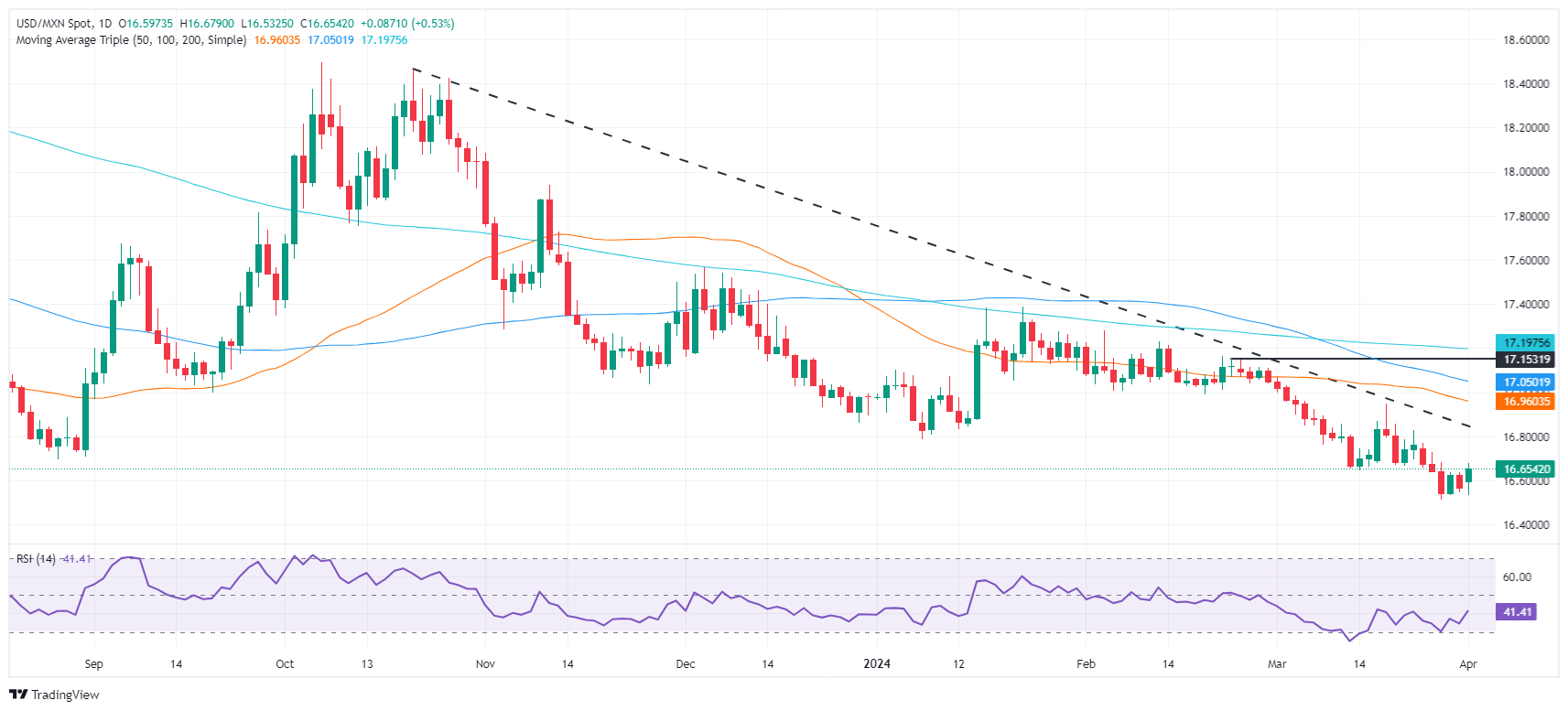Mexican Peso losses ground against US Dollar on robust US ISM data

- Mexican Peso drops as a reflection of investor reaction to upbeat US manufacturing figures and a surge in Treasury yields.
- Mexico’s manufacturing sector shows stability, but stronger US economic outlook overshadows domestic positive data.
- Despite interest rate differential favoring Mexican Peso, hints emerge of possible Banxico rate cuts.
The Mexican Peso begins the week on a lower note versus the US Dollar, tumbling 0.57% after strong economic data from the United States (US) that could prevent the Federal Reserve (Fed) from cutting borrowing costs. That and a softer manufacturing activity report in Mexico kept the Greenback bid against the emerging market currency. The USD/MXN trades at 16.65, up 0.62%.
Mexico’s S&P Global Manufacturing PMI came at 52.2, virtually unchanged from 52.3 in February. Pollyanna de Lima, economic associate director at S&P Global, said, “Mexico’s manufacturing sector expanded further in March, underpinned by a solid rise in domestic new orders as pending contracts continued to get the green light. This buoyant client appetite had positive impacts on factory production, buying levels and employment.”
Across the border, the Institute for Supply Management (ISM) revealed that manufacturing activity expanded for the first time in the US since September 2022, while an index of prices paid surprisingly jumped to levels last seen in August 2022.
The data sent US Treasury yields skyrocketing, while the US Dollar Index (DXY) soars above 105.00 and gains 0.49%. Upbeat data weighs on the Mexican currency, which has been appreciating by the wide interest rate differential between Mexico and the US.
Daily digest market movers: Mexican Peso treads water after strong US manufacturing activity figures
- Last Monday, Banxico Governor Victoria Rodriguez Ceja remained dovish despite acknowledging that the battle against inflation hasn’t been won. She added, “When macroeconomic conditions and the inflationary outlook allow us to make additional adjustments to the reference rate to the one we already have, I consider that they would be gradual.”
- A weaker Mexican Manufacturing PMI, along with the Indicator of General Economic Activity contracting in January, could open the door for further easing by Banxico. The latest meeting minutes will be released on April 4.
- The ISM Manufacturing PMI expanded by 50.3, above forecasts of 48.4, smashing February’s 47.8 reading. The Prices Paid Index expanded to 55.8, its highest level since August 2022, when it hit 52.5.
- S&P Global revealed the latest revision of March’s Manufacturing PMI for the United States, which came in at 51.9, up from the previous reading of 52.2.
- Last week, the Core Personal Consumption Expenditure (PCE) price index, the Fed’s favored gauge for inflation, cooled as expected.
- Chair Powell said at San Francisco Fed: “The fact that the US economy is growing at such a solid pace, the fact that the labor market is still very, very strong, gives us the chance to just be a little more confident about inflation coming down before we take the important step of cutting rates.”
Technical analysis: Mexican Peso at risk of shifting neutral as USD/MXN hovers around 16.65
The USD/MXN daily chart depicts that buyers lifted the exchange rate to a new four-day high of 16.67. Yet they still need to achieve a daily close above last year’s low of 16.62 before moving to test the 50-day Simple Moving Average (SMA) at 16.95. Further upside is seen at the 100-day SMA at 17.05, ahead of the 200-day SMA at 17.19.
On the flip side, the USD/MXN might extend its losses if it remains below 16.62. A breach of the current year-to-date (YTD) low of 16.51 can pave the way toward the October 2015 swing low of 16.32.
Banxico FAQs
The Bank of Mexico, also known as Banxico, is the country’s central bank. Its mission is to preserve the value of Mexico’s currency, the Mexican Peso (MXN), and to set the monetary policy. To this end, its main objective is to maintain low and stable inflation within target levels – at or close to its target of 3%, the midpoint in a tolerance band of between 2% and 4%.
The main tool of the Banxico to guide monetary policy is by setting interest rates. When inflation is above target, the bank will attempt to tame it by raising rates, making it more expensive for households and businesses to borrow money and thus cooling the economy. Higher interest rates are generally positive for the Mexican Peso (MXN) as they lead to higher yields, making the country a more attractive place for investors. On the contrary, lower interest rates tend to weaken MXN. The rate differential with the USD, or how the Banxico is expected to set interest rates compared with the US Federal Reserve (Fed), is a key factor.
Banxico meets eight times a year, and its monetary policy is greatly influenced by decisions of the US Federal Reserve (Fed). Therefore, the central bank’s decision-making committee usually gathers a week after the Fed. In doing so, Banxico reacts and sometimes anticipates monetary policy measures set by the Federal Reserve. For example, after the Covid-19 pandemic, before the Fed raised rates, Banxico did it first in an attempt to diminish the chances of a substantial depreciation of the Mexican Peso (MXN) and to prevent capital outflows that could destabilize the country.
